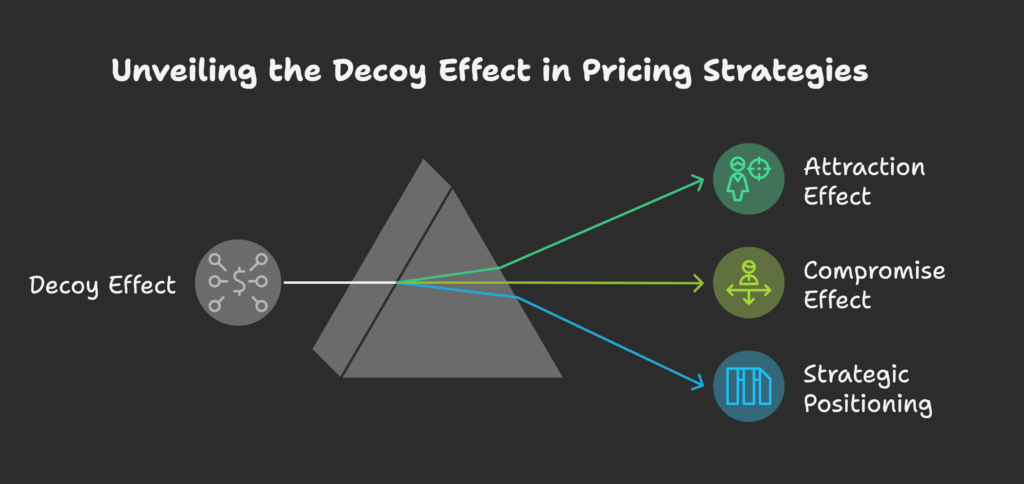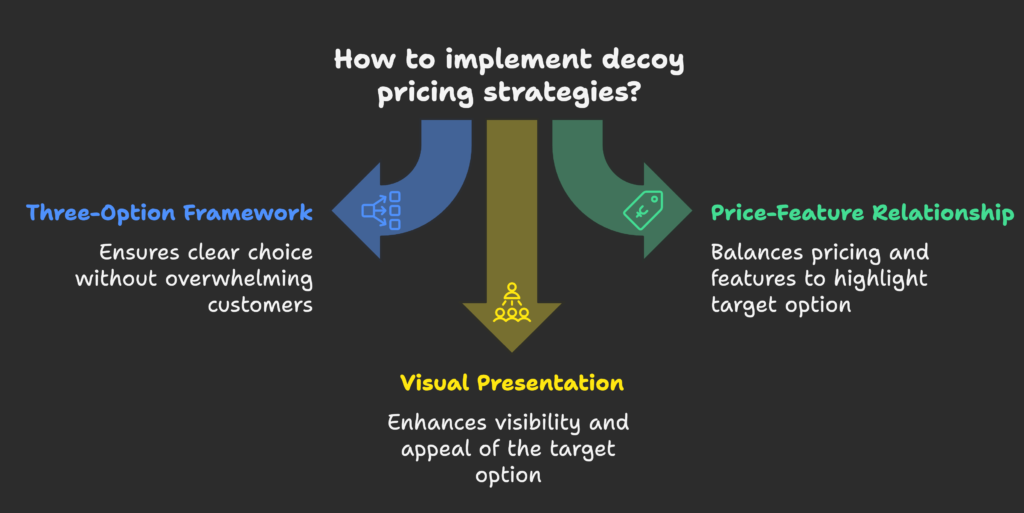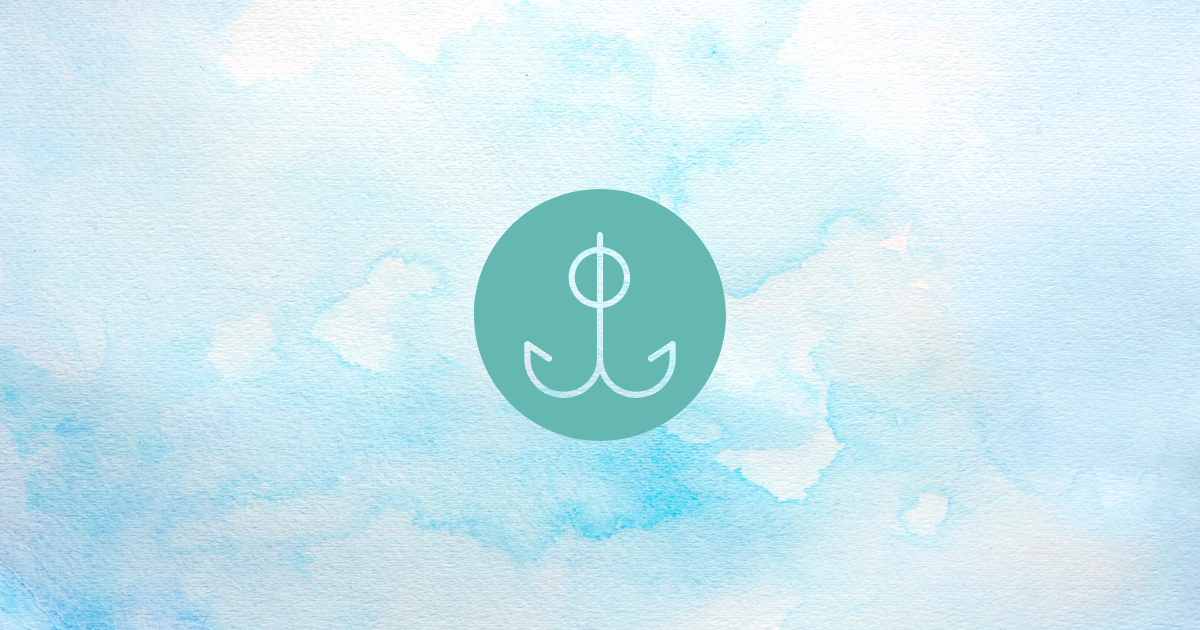Have you ever faced a choice between two products and suddenly noticed a third option that somehow made the decision feel easier? Surprise! You might have just met the decoy effect. In this article, you will learn how the decoy effect shapes our decisions, how businesses use it to guide customers toward a specific product, and how you can harness it ethically. Ready to uncover the secrets behind strategic pricing? Let’s jump right in!
Introduction to the Decoy Effect
In this section, you’ll discover the basic concept of the decoy effect, why it is often called the “asymmetric dominance effect,” and how it has evolved in behavioral economics over time. By the end, you’ll understand how businesses strategically introduce a third option to guide our buying decisions.
Definition and Conceptual Framework
The decoy effect is a cognitive bias where the presence of a “decoy” option influences us to choose one product or service over another. It is sometimes called the “asymmetric dominance” or “attraction” effect because the decoy is typically inferior to one specific product (the target), making that target look much more appealing. Historically, behavioral economists noticed that consumers rarely judge products by their absolute values; instead, they compare one to the other.
The Psychology Behind the Decoy Effect
Human brains naturally lean on shortcuts, or biases, to simplify decisions. One of these is the compromise effect, where we choose the middle ground to avoid extremes. Another is the attraction effect, where we pick an option because it clearly seems better than the inferior (decoy) choice. Essentially, when we can easily spot that one choice is less attractive, it makes the other look like a better deal.
The Business Case for Implementing Decoy Pricing
Businesses often use decoy pricing to increase sales and optimize revenue. A famous example is when The Economist used a special decoy subscription package, boosting sales by up to 43% [1]. By guiding customers toward a more profitable product or service, companies gain a competitive edge. Yet, they must balance profit goals with genuine customer satisfaction.
We’ve now explored the essence of the decoy effect and why businesses love it. Next, we’ll dive into the deeper psychology behind how our minds respond to these pricing tricks. Curious? Let’s keep going!
Psychological Foundations of the Decoy Effect
In this section, you’ll see how cognitive biases, comparative judgments, and even our brain chemistry play a role in the decoy effect. By the end, you’ll have a clearer view of why we find some options more appealing than others, even if it doesn’t seem rational at first glance.
Cognitive Biases in Consumer Decision-Making
Our minds do not always measure value on a fixed scale. Instead, we look at relative value. We also tend to avoid extremes, often preferring a middle option that feels like a safer choice. Because our brains have limited capacity, we rely on shortcuts to process information quickly. This is where the decoy can guide our thinking by making a certain product seem like the “smart” or “reasonable” pick.
The Role of Comparative Judgment
When we face multiple choices, we naturally compare them. If two products are different in one attribute (like size or features) but similar in another (like price), we focus on the attribute that seems easiest to weigh. If the decoy is clearly worse on certain attributes, the target option shines in comparison. This comparative lens makes the target look like the best compromise.
Neurological Basis for Comparative Decision-Making
Brain scans show that when we compare products, specific areas of the brain (including parts of the prefrontal cortex) become active. We also get small bursts of dopamine when we spot a good deal or a clear value difference. This chemical reward system reinforces our decision-making process, especially when we feel like we are getting a better option compared to an inferior one.
We’ve covered what happens inside our brains and how we compare options. In the next section, we’ll uncover the main tricks—or core mechanisms—of the decoy effect. Let’s keep the momentum going!
Core Mechanisms of the Decoy Effect
Here, you’ll learn about the two main concepts—attraction and compromise—that power the decoy effect. By seeing how each mechanism works, you’ll be better prepared to create or identify decoys in real-life pricing strategies.

The Attraction Effect
The attraction effect occurs when a decoy is asymmetrically dominated. That means the decoy is worse in all or most respects compared to one choice (the target), but not necessarily worse compared to the other. By being obviously inferior to the target, the decoy pushes customers to choose the target, which suddenly appears far more appealing.
The Compromise Effect
The compromise effect comes into play when the target option is positioned as the “middle” choice. People often dislike extreme options—too expensive or too cheap—so the middle option feels “safer.” Businesses sometimes set one product at a very high price and one at a very low price. This makes the middle item look like the perfect compromise.
Strategic Positioning of Options
Successful decoy strategies rely on making certain features or price points easy to compare. If the target is slightly better on important features yet only a bit more expensive than the decoy, it will stand out as the better deal. Visual layouts and labels can also boost the effect, drawing attention to the differences that matter most to consumers.
Now that you understand the core mechanics behind decoy pricing, it’s time to see how to implement them. Ready for some practical steps? Let’s move on!
Implementing Decoy Pricing Strategies
In this section, you’ll explore how to design effective decoy strategies with just the right number of choices, the right mix of price and features, and a clear visual layout. By the end, you’ll be well-equipped to apply these methods in your own business or spot them as a consumer.

The Three-Option Framework
Most marketers agree that three is the magic number. One option acts as the “competitor,” another as the “target,” and the third as the “decoy.” If there are too many options, customers can feel overwhelmed. If there are too few, you can’t create a strong decoy relationship. Clear separation among the three options is key.
Price-Feature Relationship Design
When creating a decoy, consider how much more (or less) you charge compared to how many extra features (or fewer features) it offers. For example:
- A slightly inferior decoy priced at a similar rate as the target. The target then appears high-value.
- A more expensive decoy that is only slightly better. This makes the cheaper target look like a bargain.
The goal is to balance profit margins while ensuring customers feel the target is the smartest choice.
Visual and Contextual Presentation
Placement and visual cues matter. If you want people to pick the middle option, place it prominently and ensure its benefits are easy to spot. Highlight the most important attributes so customers can quickly see the clear difference between the decoy and the target.
You now have the nuts and bolts of decoy implementation. Next, we’ll look at specific industries, from subscriptions to e-commerce, to see how they use these ideas in real-world scenarios. Keep reading to see decoy pricing in action!
Industry-Specific Applications
By the end of this section, you’ll see how different industries—from magazines to streaming services—leverage the decoy effect. These examples will help you connect theory to reality.
Subscription and Service-Based Models
One classic example is The Economist subscription offer. They introduced a print-only, digital-only, and combined print-digital plan. The middle or combined option acted as the decoy, pushing customers toward a higher-priced choice. Streaming services like Netflix also use tiered pricing, where certain features (like HD streaming) make the mid-tier look like the perfect balance between price and quality.
Retail and Consumer Products
Have you noticed different popcorn sizes at the movie theater? Often, the medium size is priced just below the large size. The large looks like a good deal by comparison. Electronics and even luxury goods also use “good, better, best” lineups to nudge consumers toward the profitable “better” or “best” options.
Digital Products and E-commerce
Online stores often display three product options side by side. The decoy may have features that are obviously not as useful or priced awkwardly high, driving customers to pick the more reasonable-looking middle or top tier. In app pricing, you may see a “basic,” “premium,” and “pro” version, with the decoy sometimes being that awkward “premium” plan nobody really wants, just to make “pro” look worth it.
Now that you know how industries apply decoy pricing, let’s see some major case studies and their success stories. Ready to explore real-life data? Let’s go!
Case Studies of Successful Implementation
Here, you’ll discover how big names like The Economist, Netflix, and Apple have used the decoy effect. These examples show the real-world impact and help us see what works.
The Economist Subscription Model
One of the most famous decoy strategies ever tested. They offered three subscription options: digital-only, print-only, or both. The both-option was the same price as print-only, making it a no-brainer for many. Sales jumped by around 40% because the “decoy” (print-only) pushed people to choose the combined plan [5]. This case showed how small tweaks can have a big effect on customer choices.
Netflix Pricing Strategy
Netflix often positions its Standard plan between the Basic plan and the Premium plan. The Basic plan might not include HD or allow only one device. The Premium plan is much more expensive but has multiple streams and Ultra HD. The Standard plan becomes an obvious sweet spot. This approach has been cited as a clear example of the decoy effect in subscription models [4].
Apple’s Product Line Pricing
Apple is known for offering multiple versions of its devices. For instance, iPhones come in varying storage capacities with noticeable price jumps. The middle storage tier can act as a decoy if a higher-end version seems too pricey, but the lowest capacity feels insufficient. Many consumers settle on the middle option, feeling it’s the best balance of price and features [8].
Seeing these success stories helps us believe in the power of the decoy effect. But how do we measure that success and know if our efforts are worth it? In the next section, we’ll dive into metrics and testing!
Measuring Effectiveness and Optimization
This section shows you how to track results when you implement decoy pricing. By the end, you’ll know which metrics matter, how to set up tests, and how to gauge customer feedback.
Key Performance Indicators for Decoy Strategies
Measuring the success of a decoy often includes:
- Conversion Rate: How many visitors are buying compared to those who leave?
- Average Order Value (AOV): Did the decoy push people to buy the more expensive option?
- Target Option Selection: What percentage of customers pick the “target” product?
- Customer Satisfaction: Do buyers feel good about their choice?
A/B Testing Methodologies
A/B tests let you change one element at a time—maybe the price difference, the feature layout, or the visual design—while keeping everything else the same. By running these tests for enough time and with a large enough group, you can see if the new decoy strategy improves results compared to your control setup.
Customer Feedback and Perception Analysis
Surveys and reviews reveal if customers feel tricked or genuinely satisfied. If they discover they were guided by a decoy, you might face a backlash. On the other hand, if they remain happy with their purchase, you have a winning formula. Long-term brand perception also matters. A happy buyer is more likely to come back.
Now that we’ve learned how to measure success, let’s look at the potential pitfalls and ethical questions around using decoys. Ready for a reality check? Let’s continue!
Ethical Considerations and Limitations
In this section, you’ll learn about the fine line between helpful guidance and manipulative tactics. We’ll cover transparency, potential backlash, and legal concerns. By the end, you’ll see that careful and ethical implementation is key to long-term success.
Transparency and Consumer Autonomy
The decoy effect can feel like manipulation if customers learn they are being nudged without knowing it. Some businesses disclose their pricing strategies openly, but that might reduce the effect. Others rely on subtle hints, trying to respect consumer autonomy while still guiding them toward a particular choice.
Potential Backlash and Reputation Risks
Social media can amplify negative feedback if customers believe they were “tricked.” If your decoy strategy is too obvious, it might harm your brand’s reputation. Balancing profit goals with a fair, transparent pricing structure is essential for long-term relationships with your audience.
Regulatory and Legal Considerations
Regulations on pricing transparency vary by country and industry. Some places require businesses to clearly outline why one product costs more than another. Staying informed about rules can help you avoid legal troubles while still benefiting from decoy strategies.
Understanding these concerns can save you a lot of trouble in the future. Next, we’ll look at advanced ways to use the decoy effect, including personalization and AI. Excited to see the cutting edge? Keep going!
Advanced Decoy Effect Applications
Now, we’ll look at next-level techniques that make decoy strategies even more precise. From personalizing options to combining multiple attributes, these ideas can help you refine your approach or spot new trends in the market.
Dynamic and Personalized Decoy Pricing
Some businesses use real-time data to adjust the decoy option based on each user’s behavior. For example, if a user often searches for premium products, the system might offer a slightly different decoy that pushes them toward a higher-tier item. As artificial intelligence evolves, these personalized decoys will become more common [3].
Multi-Attribute Decoy Strategies
The decoy effect can go beyond just price and features. It might involve several attributes at once, such as product size, color options, warranty length, or customer service level. When customers see multiple reasons to choose the target product, the decoy effect can be even stronger.
Cross-Selling and Upselling Applications
Sometimes, a decoy works best when paired with related items. For instance, a bundle package could serve as a decoy if it’s priced to make the single-product option look too basic. This strategy encourages customers to upgrade, boosting their total spend.
These advanced techniques show how adaptable decoy pricing can be. Next, let’s explore the future of the decoy effect and how consumer awareness might change the game.
Future Trends in Decoy Effect Implementation
In this section, you’ll learn about cutting-edge developments and emerging consumer habits that might shape the decoy effect. By the end, you’ll see how technology and changing customer awareness levels can affect the future of decoy strategies.
Technological Advancements
Artificial intelligence can analyze browsing habits to optimize decoys instantly. Some companies test different layouts and prices on the fly, finding the perfect balance for each customer. Virtual and augmented reality could also change how we see and compare products, opening new spaces for decoy effects [6].
Evolving Consumer Awareness
As people learn more about behavioral economics, they become harder to nudge. Some shoppers actively look for decoys and try to avoid them. Companies may need to innovate or be more subtle, ensuring the decoy still works but doesn’t annoy informed customers.
Integration with Other Pricing Strategies
Decoy pricing often pairs well with other methods, like dynamic pricing or loyalty programs. Imagine a system that not only changes prices based on supply and demand but also adds a decoy to steer you toward a particular choice. When done ethically and transparently, it can be a powerful boost to sales.
With the future in mind, let’s turn to a practical guide on how to implement these ideas effectively. Ready to build a decoy strategy step by step? Let’s get started!
Practical Implementation Guide
Here, you’ll find an easy-to-follow process for creating a decoy strategy, along with common mistakes to watch out for. By the end, you’ll have a checklist to get started on your own decoy pricing strategy, no matter your business size.
Decoy Strategy Development Process
Here’s a simple roadmap:
- Identify Your Target Product: Which item do you want customers to choose most often?
- Design the Decoy: Create an option that is clearly less attractive or more expensive in a way that highlights the target’s benefits.
- Set Up a Competitor Option: Offer another product that isn’t as appealing as the target but not so bad it feels irrelevant.
- Test and Refine: Use A/B testing to see if your decoy is effective and adjust accordingly.
Common Pitfalls and How to Avoid Them
- Making the Decoy Too Obvious: If people spot it right away, it can backfire.
- Not Differentiating Enough: If all products feel too similar, you lose the impact.
- Forgetting Brand Positioning: A decoy should still fit your brand image.
- Ignoring Customer Segments: Different groups may respond differently to the same decoy setup.
Implementation Checklist and Best Practices
- Ensure each option is visually distinct.
- Make the decoy price or features clearly compare poorly to the target.
- Test with small groups to confirm the effect before rolling it out widely.
- Monitor your metrics and gather feedback to refine the strategy.
You’re almost an expert on setting up a decoy strategy. Finally, let’s tie everything together and look at the big picture in our concluding section. Onward!
Conclusion: The Strategic Value of Decoy Pricing
This last section recaps the main ideas and offers a roadmap for using decoy pricing in your own ventures. By the end, you’ll see how decoy pricing can be a long-term tool if balanced with ethical considerations and continuous improvements.
Summarizing the Key Principles
The decoy effect works because of cognitive biases that make us compare options rather than measure them independently. This strategy can boost revenue and guide customers toward products you want them to choose. Yet it must be handled with care to maintain trust.
Implementation Roadmap
Start by analyzing your current prices and products. Look for a target option that needs a sales boost. Design a decoy that highlights the value of that target, test it, and keep refining based on feedback. Over time, you can expand decoy strategies across more products or services.
The Future of Choice Architecture
The decoy effect is part of a bigger movement in choice architecture, where businesses shape decisions through layout and information flow. As technology advances, we will see more adaptive and personalized decoys. With ethical practices and customer satisfaction in mind, the decoy effect can be a sustainable way to stand out in crowded markets.
Extra Tip for Shopify Store Owners: Want to boost your sales even more? Consider using Growth Suite—it offers helpful tools for tracking and optimizing your pricing strategies. If you’re curious about how to make your Shopify store shine, this could be the next step in your journey!
Don’t forget to check The E-commerce Conversion Booster: Mastering Pricing & Presentation Psychology guide.
References
- Lokad. (2015, July). Decoy Pricing Definition. https://www.lokad.com/decoy-pricing-definition/
- Shopify. (2023, July 3). What Is Decoy Pricing and How Can It Work for Your Business? https://www.shopify.com/enterprise/blog/108418950-decoy-pricing-the-strategies-your-competitors-use-to-get-customers-to-buy-more
- Simon-Kucher. (n.d.). Positioning decoy pricing to shape how customers perceive value. https://www.simon-kucher.com/en/insights/positioning-decoy-pricing-shape-how-customers-perceive-value
- Segmentify. (2024, February 5). Decoy Effect: Definition, Mechanics, and Examples [2024]. https://segmentify.com/blog/decoy-effect/
- Roche, J. (2024, February 15). What Is The Decoy Effect? — The Secret Behind 40% More Sales. https://josiahroche.co/blog/what-is-the-decoy-effect/
- Price2Spy. (2025, February 27). Decoy Effect in Pricing: Strategies for Business Success. https://www.price2spy.com/blog/decoy-effect-in-pricing/
- Atlantis Press. (n.d.). Analysing the Decoy Effect on Online Product Purchasing Preference. https://www.atlantis-press.com/article/125938402.pdf
- Tasmanic. (2024, December 19). Decoy effect: what is it? Examples & application. https://www.tasmanic.eu/blog/decoy-effect/





[…] The Decoy Effect: Strategic Pricing to Guide Customer Choices The Law of Contrast in Pricing Strategies Using the Framing Effect to Optimize Product Descriptions Visual Persuasion: Images That Trigger Action […]